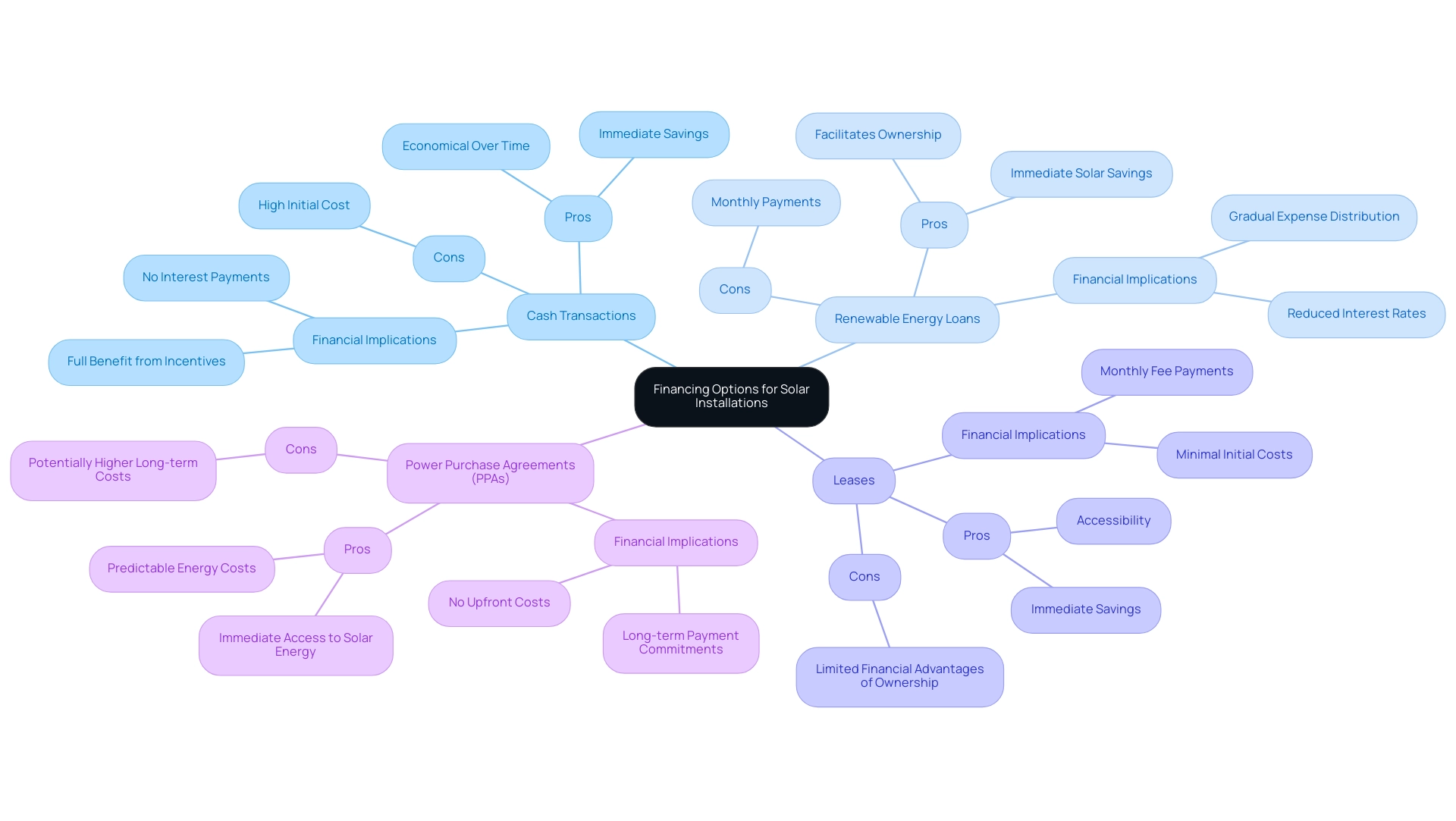Overview
We understand that rising energy bills can be a significant concern for homeowners. Going solar can be a wonderful solution, offering not just financial relief but also a path toward energy independence. By investing in solar energy, you could save around $1,500 annually on utility expenses, thanks to reduced energy costs and generous tax incentives. This is not just a financial decision; it’s a step towards a more sustainable future.
Photovoltaic systems are designed to lower your energy costs while also boosting your property value. With federal and state incentives available, making the switch to solar is not only economically viable but also environmentally responsible. Together, we can create a more sustainable community, one home at a time.
It’s common to feel overwhelmed by the options available, but rest assured, we are here to guide you through every step of the process. Let’s work towards a brighter, greener future for your home and our planet. If you’re ready to explore how solar energy can benefit you, please reach out. We’re excited to support you on this journey.
Introduction
As homeowners, it’s natural to feel concerned about rising energy costs. You may be searching for sustainable solutions that not only alleviate financial burdens but also contribute to environmental responsibility. In this pursuit, solar energy stands out as a powerful ally, offering the potential to significantly reduce monthly electricity bills while enhancing property values. The allure of solar installations is undeniable, especially when you consider the attractive federal and state incentives available to you.
These financial benefits are becoming increasingly compelling, even as challenges like fluctuating installation rates and changing regulations may seem daunting. Together, we can explore the multifaceted advantages of solar energy for homeowners like you. From cost savings and financing options to local incentives that can facilitate a seamless transition to renewable energy, we are here to support you every step of the way.
Let’s work towards a brighter, more sustainable future.
The Financial Upside of Solar Energy for Homeowners
We understand that rising energy bills can be a significant concern for many homeowners. The financial benefit from solar power is a comforting solution, primarily through decreased utility expenses and appealing tax incentives. By investing in photovoltaic panels, whether monocrystalline or polycrystalline, residents can anticipate significantly reducing their monthly electricity expenses, with solar savings projected at around $1,500 per year. This decrease in utility costs is further enhanced by the federal tax incentive for photovoltaic systems, which allows property owners to deduct 30% of their installation expenses from their federal taxes, making renewable investments even more financially appealing.
It’s common to feel overwhelmed by the technical aspects of solar installations, but it’s important to ensure your electrical panel is at least 200 amps to accommodate the power produced by these systems. Installing photovoltaic panels not only cuts utility expenses but also contributes to environmental sustainability by decreasing carbon emissions and fostering a cleaner power future.
Moreover, renewable power systems can raise property values, positioning them as both a cost-saving solution and a smart investment for property owners. Solar panels require little to no maintenance over their lifetime, and leading brands offer comprehensive 25-year warranties, ensuring long-term reliability and value. This aligns with the growing trend of eco-conscious homeowners seeking sustainable solutions that enhance their energy independence.
As Emily Walker aptly stated, “Annual utility rate inflation is one of the biggest reasons it makes sense to adopt renewable energy.” This quote highlights the financial rationale behind renewable energy investments. Despite recent challenges, including a decline in residential installations in Q3 2024 due to high electricity bills and changes in California’s net metering rules, the demand for sustainable power solutions continues to grow, making the financial advantages of photovoltaic systems increasingly compelling.
Additionally, initiatives such as the Biden-Harris administration’s $7 billion Solar for All program are working to enhance access to renewable power, ensuring that the benefits of photovoltaic technology are shared fairly among various communities. With the right setup in place, homeowners can enjoy long-term savings, contribute to job creation, and support equitable access initiatives, all while promoting a more resilient power future. Together, we can embrace these sustainable solutions and work towards a brighter, cleaner energy future.
How Solar Energy Reduces Monthly Energy Costs
We understand that rising energy bills can be a significant concern for many homeowners. Solar energy installations harness sunlight to generate electricity, which can significantly reduce your dependence on grid power and lead to lower monthly energy bills. In California, where electricity prices rank among the highest in the United States, the potential savings are considerable. For instance, the typical expense of a 6.1 kW energy panel setup is roughly $14,000 prior to incentives, which can significantly reduce the average yearly electricity usage of 11,040 kWh.
This translates to substantial savings over time, especially considering that the average payback period for photovoltaic energy in the state is around 5.92 years. Imagine the relief of having more manageable energy costs!
Furthermore, homeowners can benefit from net metering, a program that permits them to sell surplus power produced by their systems back to the grid. This not only aids in further lowering electricity expenses but also contributes to a more sustainable power ecosystem. The financial benefits are further enhanced by the federal tax credit for renewable energy, making the initial investment in this technology more accessible and manageable.
Case studies demonstrate the measurable effect of renewable power on monthly costs. For instance, programs under the 200% rule have allowed property owners to optimize their panel sizes, ensuring they can produce sufficient power to meet their requirements while gaining extra savings. A case study from Powercore Electric highlights how homeowners have successfully implemented these systems, resulting in significant reductions in their utility bills.
Moreover, ‘Community Solar Projects’ highlight initiatives that enable renters to save on electric bills without needing to install solar panels directly on their properties. Participants in these projects can anticipate annual savings, although the precise amount may differ depending on individual electricity usage and the project’s power generation capabilities.
As Michael Campbell, assistant deputy director of resources at Cal Advocates, notes, “We generally think they’ve been set a bit too high,” referring to electricity rates. It’s common to feel frustrated by these rising costs, and this sentiment resonates with California residents increasingly seeking ways to mitigate their expenses. The shift to renewable power, particularly solar, not only provides prompt financial assistance but also encourages long-term self-sufficiency and sustainability, making it an attractive option for environmentally aware residents.
Furthermore, comprehending residential photovoltaic panel dimensions is essential for property owners contemplating renewable power options, as it directly influences their capacity to optimize power production and savings. Together, we can explore how solar energy can transform your energy experience into one that is more sustainable and cost-effective.
Exploring Financing Options for Solar Installations
Homeowners often face the daunting challenge of managing energy bills, and thankfully, there are a variety of financing options available for energy installations, each tailored to different financial situations and long-term goals. The main methods include cash transactions, renewable energy loans, leases, and power purchase agreements (PPAs).
Cash transactions are frequently viewed as the most economical choice over time, as they eliminate interest payments and enable property owners to fully benefit from available state incentives, such as tax credits and energy storage rebates. These incentives play a crucial role in boosting demand for renewable energy, significantly enhancing the financial benefits of adopting technology like solar. However, we understand that many property owners discover photovoltaic loans as a feasible option, generally presenting reduced interest rates compared to conventional loans.
This funding approach allows homeowners to distribute the expense of their photovoltaic installations gradually, which translates to immediate solar savings on power. Leases and PPAs are especially attractive for those who wish to set up photovoltaic installations with minimal to no initial costs. These arrangements enable property owners to pay a monthly fee instead of buying the system outright, making renewable energy more accessible.
Yet, it’s essential to consider the long-term implications, as these options may not provide the same level of savings as cash purchases or loans. Understanding the pros and cons of each financing option is crucial for maximizing savings and ensuring a successful investment. For instance, while photovoltaic loans can facilitate ownership and potential savings, they also come with monthly payments that need to be factored into the homeowner’s budget. In contrast, leases and PPAs can provide immediate savings, but the financial advantages of ownership may be limited.
Recent statistics indicate that 38% of companies in the industry anticipate growth in 2025, reflecting a positive outlook. Ben Zientara, a writer and energy policy analyst, notes that an additional 35% of companies in the field expect to maintain the same level of business. Additionally, a survey revealed that 54% of installers expect to sell more energy systems in the coming year, although only 25% reported an increase in demand.
This emphasizes the significance of comprehending financing alternatives as property owners navigate their renewable energy journey. Case studies indicate that homeowners primarily install photovoltaic panels to reduce costs, while battery storage is frequently chosen for backup power functionalities. This shift in consumer priorities underscores the need for energy companies, like Powercore Electric, to tailor their offerings to align with customer needs and preferences.
Powercore Electric offers a range of financing choices and services that assist property owners in making informed decisions regarding their energy investments. Furthermore, concerns about potential tariffs and changes to incentives related to solar energy were expressed by 56% of companies surveyed, indicating that the current market climate can impact financing options. As the renewable market develops, remaining aware of funding alternatives will empower homeowners to make choices that enhance their autonomy and financial health.
For a step-by-step guide on navigating the installation process, homeowners can refer to resources provided by Powercore Electric. Together, we can work towards a sustainable future that benefits both your household and the planet.
Long-Term Financial Benefits of Solar Energy
Investing in renewable power brings solar benefits that not only yield immediate savings but also offer substantial long-term financial advantages. We understand that many homeowners are concerned about rising energy bills. Homes fitted with photovoltaic panels represent an investment that equals solar, often leading to a rise in property value. Studies show that such installations can boost home values by an average of 4.1%. This increase is particularly significant in California, where the demand for sustainable energy solutions is on the rise.
Furthermore, assessing energy service providers is essential, as the ownership status of these installations can affect home value. Third-party-owned installations, such as those obtained through leases or power purchase agreements (PPAs), may complicate the selling process and add less value compared to units bought outright. Comprehending the operation of photovoltaic systems is also crucial for property owners. These setups are intended for minimal upkeep, leading to reduced operational expenses throughout their lifespan. For instance, property owners should consider the differences between various energy service providers, as some may offer better warranties, customer service, or installation practices than others. This can significantly impact long-term satisfaction and financial returns.
As power costs keep rising, homeowners with photovoltaic systems find that their stable utility expenses equal solar protection from future price increases. This financial predictability, combined with the appreciation in property value, positions renewable energy, which equals solar, as a prudent long-term investment. It’s common to feel uncertain in light of recent trends, such as a 4% decline in residential renewable energy installations in Q3 2024 due to high electricity costs, power outages, and changes in California’s net metering rules. However, the long-term outlook remains optimistic.
Emerging markets are anticipated to propel growth in renewable energy adoption, reinforcing the financial viability of investments in this sector. Furthermore, it is essential to consider that permits and fees can add a few thousand dollars to the total installation cost, accounting for about 8% of the total. Homeowners who invest in photovoltaic systems, which equals solar energy, not only increase their property value but also contribute to a sustainable future. Together, we can make renewable power a compelling choice for eco-conscious individuals.
Moreover, investigating government panel initiatives can offer additional financial benefits, enhancing the shift to renewable sources even more appealing. Comprehending how photovoltaic panels function, including their efficiency ratings and power output, can also assist property owners in making informed choices regarding their renewable investments. Let’s work towards a brighter, more sustainable future together.
Navigating Local Incentives and Regulations for Solar Savings
As a homeowner, you might be feeling the pinch of rising energy bills and wondering about sustainable solutions. Beyond federal tax credits, California property owners can benefit from a range of state and local incentives designed to encourage the use of renewable power. The California Solar Initiative, for instance, offers substantial rebates for photovoltaic installations, significantly reducing those upfront costs. Additionally, net metering regulations allow property owners to gain credits for any surplus power their setups generate, which can further enhance your savings.
Looking ahead to 2025, the Self-Generation Incentive Program (SGIP) stands out by offering rebates of up to $200 per kWh for installing batteries alongside photovoltaic systems. This initiative not only addresses the growing concern of power outages but also encourages homeowners to invest in storage solutions. In fact, installations that combine photovoltaic and battery systems can achieve a median payback period of only eight years—two years shorter than for photovoltaic-only setups. As Ben Zientara, a policy analyst for renewable energy, insightfully notes, “Considering all the incentives available, the payback period of the average photovoltaic+battery installation in California is about eight years.”
Local incentives, such as rebates and financing options from utility companies and municipalities, play a crucial role in making solar power more accessible. Many local initiatives have proven effective, as evidenced by numerous success stories from residents who have experienced decreased utility expenses and greater power independence. For example, the DSGS program reimburses Tesla Powerwall owners for permitting remote control of their batteries, further encouraging the adoption of storage solutions.
Powercore Electric also offers extensive solutions that empower property owners to save with renewable energy, store clean power, and enhance their homes with roofing upgrades. Staying informed about these local incentives and regulations is essential for property owners aiming to maximize their financial advantages from photovoltaic investments. By understanding the landscape of solar incentives in California, we can navigate potential challenges together and ensure compliance, ultimately leading to a more rewarding solar experience.
Conclusion
Investing in solar energy presents a compelling opportunity for homeowners who are understandably concerned about rising electricity bills. By significantly reducing monthly expenses through solar installations, many homeowners can expect average annual savings of around $1,500. Coupled with attractive federal tax credits and state incentives, the financial rationale for transitioning to solar becomes even more persuasive. The ability to lower energy costs while enhancing property values makes solar energy not just a cost-saving measure but a strategic investment for the future.
We understand that navigating financial decisions can be daunting, which is why the various financing options available—such as cash purchases, solar loans, leases, and power purchase agreements—cater to diverse financial situations. This ensures that solar energy is accessible to a wider audience. By understanding these options, homeowners can choose the best path for their circumstances, maximizing long-term savings and energy independence.
Furthermore, the long-term financial benefits are reinforced by the increasing property values associated with solar installations, along with the predictability of energy expenses amid rising utility rates. As the solar market evolves and more incentives are introduced, such as California’s Self-Generation Incentive Program, homeowners are better positioned to capitalize on the advantages of renewable energy.
Ultimately, embracing solar energy is not just a personal financial decision; it is a commitment to a sustainable future. By making informed choices about solar investments and staying updated on local incentives, homeowners can play a crucial role in fostering a cleaner, more resilient energy landscape. Together, we can reap the rewards of this investment for years to come. Let’s work towards a brighter, more sustainable future together.







